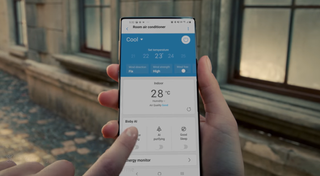Samsung Galaxy S30: Release date, price and what we want
The Samsung Galaxy S20 series has lived up to the hype in some ways but has been a letdown in others, especially in terms of early bugs and high prices. So it’s not a surprise that some are already looking ahead to the Samsung Galaxy S30.
Of course, it’s still very early in the Galaxy S30 rumor cycle, but we’ve already seen some leaks for Samsung’s next flagships. And we also have our own wishlist for the Galaxy S30 series.
Based on the earliest rumors, it looks like Samsung could finally deliver a true full-screen phone in the Galaxy S30 and an even more sophisticated camera system. But there are plenty of other areas for improvement based on our Galaxy S20 review, Galaxy S20 Plus review and Galaxy S20 Ultra review.
Here’s what we’ve heard so far about the Galaxy S30 and what we would like to see from Samsung for its 2021 phones.
Samsung Galaxy S30 latest news (Updated June 5)
- Samsung is expected to begin production on its next in-house flagship chipset, the Exynos 992, in August. The Exynos 992 will likely be incorporated in international versions of the Galaxy S30.
- The North American version of the Galaxy S30 is expected to be powered by the Snapdragon 875, an unannounced processing platform from Qualcomm that would be the chip maker’s first 5-nanometer chipset.
- Leaked Galaxy S30 benchmarks using Samsung’s upcoming flagship CPU hint at a 3x speed improvement over the Snapdragon 865 powering the Galaxy S20.
- The Galaxy S30 could feature a 150-megapixel camera, improving on the 108MP sensor in this year’s Galaxy S20 Ultra.
Samsung Galaxy S30 release date

The Samsung Galaxy S20 series was launched this year at a Samsung Unpacked event February 11 and the phones went on sale March 6. Pre-orders started Feb 21. If Samsung followed a similar schedule for its next phones, the Galaxy S30 release date would be March 5, which would be the first Friday in the month.
If Samsung stuck with similar timing for the Unpacked 2021 event as well, the Galaxy S30 would launch February 9, which would be the second Tuesday that month. And pre-orders would begin as soon as Feb. 19. Of course, that time frame doesn’t take into account any delays or rescheduling caused by the ongoing coronavirus pandemic.
Samsung Galaxy S30 price
Samsung made a gamble with the Galaxy S20 line by not offering a cheaper Galaxy S20e variant in the $700 to $750 range. Instead, the cheapest Galaxy S20 was $999. The Galaxy S30 price will presumably be in the same ballpark, with the prices starting at $999 / £899 / AU$1,499 for the regular Galaxy S30.
The Galaxy S30 Plus would presumably costs $200 more and the and Galaxy S30 Ultra $200 more than that.
Samsung Galaxy S30 cameras

The Galaxy S30 is rumored the up the ante even more when it comes to camera resolution. A report from SamMobile says that Samsung may be developing a new 150MP sensor for flagship phones. This would be even sharper than the 108MP sensor in the Samsung Galaxy S20 Ultra.
Not much is known about this sensor, but apparently it has a footprint of 1 inch and it uses the same Nanocell technology that the S20 Ultra does with its ISOCELL Bright HM1 sensor. The new 150MP sensor will likely show up in phones for the first time in Q4 2020, possibly a Xiaomi handset.
Other phone makers could also beat the Galaxy S30 to the punch in employing this camera, including Oppo and Vivo, but Samsung will likely make the most noise. What’s not know is whether Samsung will reserve the sensor for the Galaxy S30 Ultra or employ it for the Galaxy S30 Plus or Galaxy S30.
One interesting bit of news reported by prominent Samsung leaker IceUniverse indicated that the company views high-megapixel sensors — like the 108MP one in the S20 Ultra — as the way forward for the industry, and will remain committed to their development. In fact, a Samsung executive who heads up the firm’s sensor business theorized that one day, the company could introduce a 600MP sensor that would technically “exceed the limits of the human eye.”
As exciting as that may sound, there’s obviously much more to good mobile camera design than a high-megapixel sensor (software plays perhaps the most critical role nowadays), and by the looks of it we’re many, many years away from seeing 600MP sensors in handsets. That said, Samsung will surely look to build upon the work it started with the S20 Ultra as it prepares its next-generation flagship, and so the Galaxy S30 could mark yet another milestone in sensor design.
Samsung Galaxy S30 design

Samsung has been working on a “perfect full-screen phone” design for well over year, and the Samsung Galaxy S30 could make this vision a reality. Samsung Display started talking about the possibility of eliminating the punch holes on the front of its phones in March 2019.
The idea is that the camera hole would be invisible, “while not affecting the camera’s function in any way.” Samsung is also eyeing technology that would leverage the display as a speaker. However, it’s not clear whether Samsung will be able to deliver this type of design in time for the Galaxy S30.
Samsung is also experimenting with displays that would be rounded on all four sides, which could come to the Galaxy S30 series. The device would still have a metal frame, but the curved panel would make the screen more immersive. This is based on a patent discovered by LetsGoDigital.
Samsung Galaxy S30: Processor and performance
If Samsung follows past practices, it will use two different chipsets to power the Galaxy S30 — the latest Snapdragon 8 Series system-on-chip for phones released in the U.S. and one of its one Exynos processors for models that ship in the rest of the world.
On the Snapdragon front, the new chipset is expected to be the Snapdragon 875, if Qualcomm sticks to its numbering conventions for new versions. An early report from 91Mobiles claims that this will be a 5-nanometer chip, as opposed to the 7-nanometer Snapdragon 865. There will also be a 5G modem included with the chipset.
Samsung’s next processor is expected to be named either the Exynos 1000 or Exynos 992, and it’ll be another 5-nanometer chip. Leaked benchmarks promise big performance gains, with the new Exynos chipset delivering a 3x improvement over the Snapdragon 865. The silicon is rumored to begin production by partner TSMC this summer according to ZDNet, though that won’t be soon enough for it to appear in the Galaxy Note 20 or Galaxy Fold 2, which will likely release in late August or early September if history repeats itself.
It’s still early days for whatever processor powers the Samsung Galaxy S30. Qualcomm usually doesn’t tip its hand about the top-of-the-line processor it has planned for the coming year until December, though we expect more leaked information about the S30’s performance between now and then.
Samsung Galaxy S30: What we want
The Galaxy S30 will be fighting the iPhone 12 by the time it is released. And it will also face competition from the Pixel 5 as well. Both those phones are expected to debut this fall, several months before the S30 would arrive.
Here’s how Samsung can improve on the Galaxy S20 while staying one step ahead of the competition.

A lower starting price: Not having a direct answer to the $699 iPhone 11 with the Galaxy S20 has been Samsung’s biggest mistake with its phone lineup. The Galaxy S20 starts at $999, which is $300 more. Samsung should find a way to make the Galaxy S30 more affordable so that there’s a least one device in the lineup that’s priced for the masses. A Galaxy S30e would not be a bad idea at all.
120Hz done right: As smooth as the 120Hz screens are on the Galaxy S20, we’ve found that they take a heavy toll on battery life. Plus, the resolution steps down from quad HD to full HD when you want to jump up from 60Hz to 120Hz. We would like to see Samsung adopt technology like Apple’s ProMotion display, which is smart enough to automatically scale the refresh rate based on what content is on screen and what you are doing.
Longer battery life: Despite packing larger batteries across the board in the Galaxy S20 lineup, Samsung’s phones did not all last as long as their predecessors on our web surfing battery test. For example, the regular Galaxy S20 lasted 10 hours and 19 minutes, compared to 9:31 for the S20. And the Galaxy S20 Plus lasted 10:31, compared to 10:56 for the Galaxy S10 Plus 5G.
Only the Galaxy S20 Ultra made our best phone battery life list with a max runtime of 12:13. However, that time dropped all the way down to 9:13 with 120Hz mode enabled. Our best guess is that the addition of 5G took a toll on the endurance of these phones, so perhaps it will take a more efficient modem from Qualcomm to deliver more juice for the Galaxy S30.
A true full-screen design: Samsung has been doing a better job than Apple at minimizing the eye sore on the front of its phones. The punch hole at the top of the Galaxy S20 is tiny compared to the notch on the iPhone 11 and iPhone 11 Pro. However, we would still like to see a a true full-screen look on the Galaxy S30.
Samsung has already teased a full-screen phone in one of its appliance ads, which could be an early look at the Samsung Galaxy Note 20. But for such a big design change our money is on the Galaxy S30, which is Samsung’s true flagship.
Less bugs at launch: The good news is that Samsung has issued a software update for the Galaxy S20 that addresses some early reviewer and user complaints. The bad news is that the company didn’t catch those issues before launching the phones. The biggest problem we had was with the Galaxy S20 Ultra, which was slow to focus when shooting video. Here’s hoping Samsung does more internal testing and quality control before releasing the Galaxy S30 lineup.


2 thoughts on “Samsung Galaxy S30: Release date, price and what we want”